Turnbull & Asser: The Sustainability Framework
This is the first article using our Sustainability Framework, which we set out on PS a couple of months ago. Its aim was to create a definition of environmental sustainability that could be used to talk to companies we cover, about their efforts to become more sustainable.
What we’re finding is that every company is on a journey. Some aspects of sustainability are easy to change, or have more impact, and so are tackled first. Others are almost impossible, or require innovation from suppliers.
None of it is simple, and everyone is different. Which is why a lot of companies don’t talk about it, and why an advert shouting that a brand has cut water waste by 67% is virtually meaningless. That kind of advertising can also make people understandably cynical.
By actually talking to companies about what they’re doing, we hope to have a more open and productive conversation. Both to improve understanding among consumers, and share advice with other small companies.
Our first conversation was with Becky French, creative director of Turnbull & Asser.
Turnbull is a nice example to kick off with, because it is neither a small company of two or three staff - as many are on PS - nor a large fashion brand.
A small company has the advantage of flexibility, and starting from scratch with suppliers. They can start with sustainability built in from the start. A big brand, on the other hand, often has dedicated sustainability staff, plus the budget to bring in consultants.
T&A has two shops in London and one in New York. It has a separate office, and both shirt and tie production in Gloucestershire. The business is still largely shirts, but it sells everything from trousers to cufflinks.
“The complexity of the product offer really makes things harder,” Becky told me, when we sat down in the Mayfair office. “It means for example that we have a huge range of packaging, all required for different sizes of product, for sale in store and online.”
However, shirts account for almost 80% of the business, so it made sense to start there.
“The first thing we did, three years ago, was switch all the external giftbox and bag packaging so that it was recycled and recyclable,” says Becky. “I think there are customer expectations about how a luxury product should look - Mr Porter probably set the benchmark - so we didn’t feel we could get away from that. But we wanted to make sure that that packaging could be re-used by customers, and it was as sustainable as possible.”
The next challenge was all the plastic inside. “Shirts have to be shipped without being damaged or the collars being crushed, and anyone who’s bought a good shirt knows how many plastic packaging accessories that requires,” Becky says.
Customers coming into Jermyn Street and buying just one shirt could perhaps do without so much packaging. But not when shipping them in bulk, for example from the factory to New York.
T&A has been around for almost 150 years, so the first thought was they must have used something before plastic. They did apparently, cardboard, but collars also got squashed.
That started a search for a replacement material - asking suppliers, asking peers, and the factory management doing the same. “The thing is, nothing exists out there in the market at the moment,” says Becky. “No one is making something we can use. So while we can talk to suppliers and let them know there is the demand, we are very dependent on them.”
One resource that was useful was Walpole, the British luxury association. It has discussion groups for members, such as T&A, and over the past six months Becky and the team have been asking everyone for suggestions.
“People were so open and happy to share, which isn’t necessarily what you would expect,” says Becky. “Someone will have a supplier they recommend; someone else will have an experience that was helpful. Everyone is trying to improve here, so there’s no shortage of searching.”
There’s also no snobbery. For example, on plastic packaging one of the most helpful Walpole members was a dry cleaning company that was trying to cut down its plastic use, as it goes through a huge volume.
“We’ve looked at so many options,” says Becky. “For a while we were talking to Flexi-Hex, which originally came up with a cardboard packaging to use on surfboards, but is now used by lots of industries.”
T&A hoped a version of the corrugated cardboard could be used to support shirt collars, but that didn’t pan out. Part of the issue is that every company is trying to become sustainable at the same time, and small companies like Flexi-Hex can’t innovate in every direction at once.
Another option being considered is replacing the collar stays with a material like bamboo. “We’re doing trials on that at the moment,” says Becky, “but I’m not sure whether it will be as reliable or, again, have that luxury finish people expect.”
There’s also a project to encourage customers to return their plastic packaging, so it can be re-used at the factory. “With a lot of these solutions, half the challenge is communication,” says Becky. “Such as encouraging people to re-use those plastic collar stays, or give them one metal set that they can use on all their shirts.”
A similar push is underway to get customers to return shirts they don’t wear any more - to be recycled or (if still wearable) given to charity.
In many areas, T&A has a bit of a head start.
“For example, encouraging people to buy less is contradictory to the interests of a lot of businesses,” says Becky.
“But we’ve always encouraged customers to bring back their shirts to be repaired, or to have collars and cuffs replaced. The team love this - there’s something very satisfying for a maker about keeping a great product going.”
Turnbull also has a lot of loyal customers around the world, and some bring in shirts that are 20 or 30 years old, to offer them for the archive. “Touring the archive as a designer is inspiring,” says Becky. “It reminds you of how great shirts can last well and, in that way, be quite sustainable.”
It should also be mentioned that Becky was wearing an archive piece herself, when we met: a boldly striped blue-and-white shirt with the collar cut off and therefore frayed. It looked very chic, at least on her.
Having its own factory helps T&A keep travel miles down. And while its raw materials come from around the world, shirting mils are among the most innovative when it comes to sustainability. Whenever I see Albini or Alumo at trade shows it feels like they talk about nothing else.
T&A is also planning to offer a range of shirts in organic cotton - which brings up an interesting question: Why not make everything in that cotton, if you want to be more sustainable?
“We could take a position on that as a business,” says Becky, “but it would make the end product more expensive for the customer. I think it’s another area where the customer can drive things - if everyone just buys the organic range, then that encourages us to make more of the product that way. We’ll see the response when we launch the range in 2022.”
It also works further down the supply chain: as more companies have asked for organic cottons, mills like Albini have increased their range, and made them available as part of their standard stock service, rather than special order.

Interestingly, the original spur for all this work was T&A’s Royal Warrant from HRH Prince Charles. The Royal Warrant is a stamp of approval for quality, yet perhaps customers aren’t familiar with anything further,” says Becky. “The criteria to retain a warrant are quite detailed in some ways.”
I didn’t know this either: the Royal Warrant has to be renewed every five years, and part of the process for those given by Prince Charles is that the company answers a set of questions on sustainability - and shows that they are constantly improving.
“In response to that we initially looked at B Corps certification. Their process is very impressive, and not easy to go through, but it is widely recognised. In the end we decided we weren’t ready for it, but it’s something that’s still on the table when team capacity allows,” says Becky
The pandemic also delayed much of the work. “Supply chains have been under so much stress in the past two years that it’s not surprising a lot got put on hold. But it was frustrating. Now we’re back on it again, sampling and actually making decisions.”
That currently includes making some shirts out of Lyocell (wood pulp) and talking more about linen, which is one of the more sustainable fibres. Both require more communication work than production.
They’re also experimenting with how shirts are stocked and stored. And looking at sourcing for other areas of the business, such as suits. “We generally use British fabrics, but the suits are made in Italy. There was a discussion of whether we should use Italian fabrics instead, to cut down on the mileage,” says Becky.
“In the end we decided not to, and that was probably right for our brand, but I think if one thing has really changed in the past few years it’s that sustainability is part of every one of those conversations.”
For me, that last statement of Becky’s is the most important of all. No one is perfect - but many companies are genuinely striving every day to be better. Hopefully this first article has given you some insight into how this actually happens - the challenges and the achievements - at one company in particular.
Read the Sustainability Framework, its definitions and aims, here




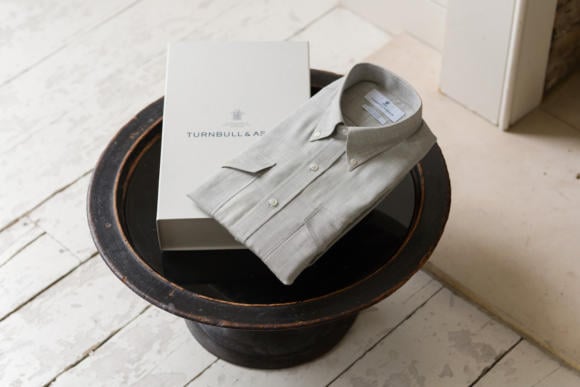
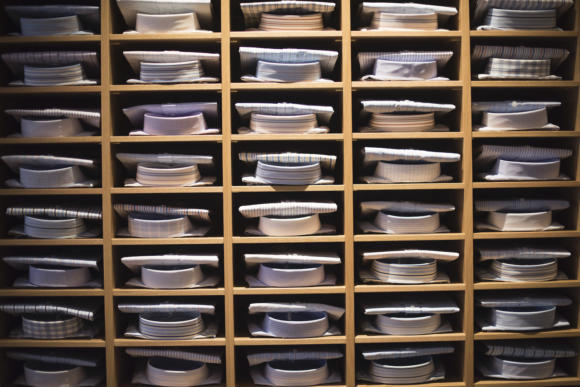
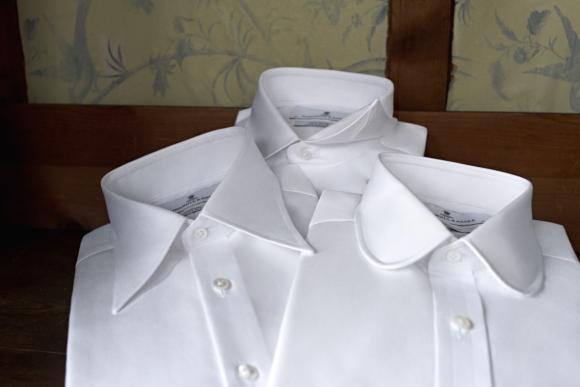
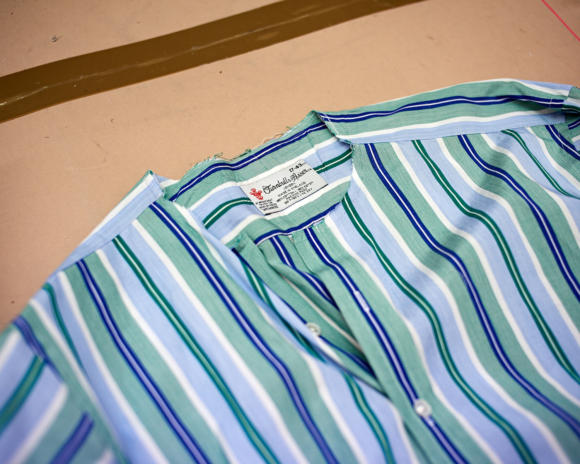
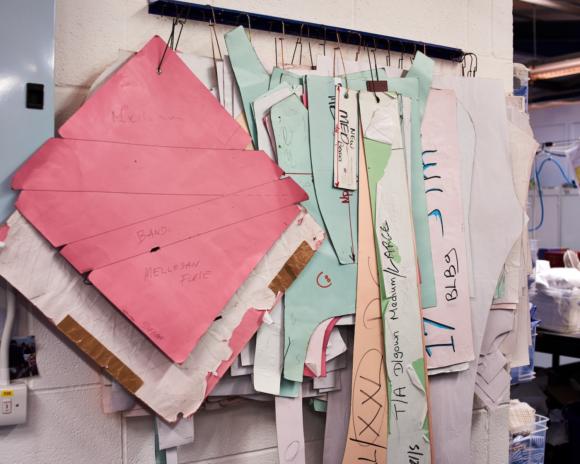
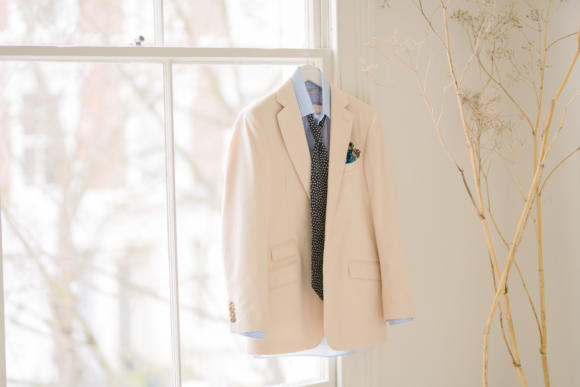



























An interesting and informative interview, Simon. One of the key takeaways for me is the procurement challenges faced by any company (large or small) attempting to re-gear their operations to be more sustainable. The drive may be there, but without solutions across the supply chain the gains appear to be marginal.
I’d like to pick up on one small thing that was highlighted in the article: I find those little pieces of plastic a genuine nuisance when buying a shirt, although I appreciate they are necessary in some respects. I doubt there would be any compromise to the quality of the product or packaging if those were to be replaced by something that does the job plastic does but which doesn’t produce a mountain of waste.
Thanks Alex, I’m pleased you think so.
Yes, the supply chain is a key issue, and not many people appreciate how much companies are reliant on each other.
And I think you’re right on the plastic packaging. The problem, as you’ve noted is finding a replacement that does the job
One of the problems is you just move the environmental issue from using oil to one of using water (for natural products).
Could you not receive shirts in a sturdy recyclable,box with contents wrapped in tissue paper, protected by compostable filling material?
Is the deeper issue the expectation customers have-I.e it’s a premium product? I realise we have discussed this before on PS.
Another thoughtful article,Simon.
Thanks Peter.
The issue with plastic packaging used to support collars, and then wrap shirts, is less about sending to the customer and more about shipping to stores, and to wholesalers. Plastic is so much better because it can be bashed around as much as you like, and it’s still sellable. That doesn’t happen with cardboard boxes. The Patagonia article we linked to in the first piece is useful in that regard.
But yes, there is a separate issue about customer expectations on packaging. Which as you say we covered previously – asked to choose between sustainability and nice packaging, most people basically said they wanted both!
I agree, a very interesting article. I’m now looking forward much more to the rest of this series.
I likewise very much dislike all that plastic in the packaging, even beyond just the environmental impact of it. For what it is worth if T&A is reading, I’d accept collars being crushed and ironing them back myself, especially if there was a marginal discount.
I’d also be happy with a single pair or re-useable collar stays with a multi-shirt purchase. I’m less bothered by the plastic collar stays, though, since those at least get continuous use for years, if not the life of the shirt.
I’m sure that’s useful C. I suspect you’re unfortunately in the minority!
Don’t most people launder new shirts before wearing them to get out any initial shrinkage (or is that just me?). In which case, it’s perfectly fine if it’s a bit wrinkled or squashed. But I get that it’s hard for a luxury retailer to sell things in that condition.
Yes – see comment above from RTK on that
When the organic cotton range is offered, I hope that there’s some ready explanation provided as to its sustainability benefits.
In general, it’s very helpful when brands give some guidance as to the environmental aspects of a product – it’s hard for consumers to make informed choices otherwise. It’s not that useful to advertise that an item has been made in England, if it’s made from Italian cloth, woven with the wool of Australian sheep.
I think you highlight a good point there Tom, which is that communication is very important – and not always an easy one to get right.
Brands can easily drown customers in technical information if they provide everything the most interested ask about. But that information should be available somewhere too.
I think it’s about tiers of detail – as in, click here for more, going several layers deep
Very interesting article – what does Becky mean by customers being able to re-use packaging? Repurpose it or store the item it came with or something else?
Any and all of the above. Anything beyond just using it to receive the product, and then throwing it away
This has given me an idea. I have a Western denim shirt that I absolutely love. The elbows have worn down and one has blown a hole. I’ve not worn it since it happened a couple of years ago and was unsure of the best thing to do with it as I definitely don’t want to bin it and I don’t fancy leather elbow patches! From your recent article on how jeans can be repaired I think I’ll ask Blackhorse Lane if they can reinforce them and maybe make a feature of the stitching on the tear.
Nice idea Con. The only restriction will be whether the denim is heavy enough to be repaired in the same way as jeans, but no harm in asking
Simon,
Thanks a really interesting interview. If I may pick up on one comment by Ms French when she stated that the company had considered changing suiting used to Italian-made in response to the airmiles issue. Laudable perhaps but wouldn’t a more positive sustainability response have been to move suit manufacture back to the UK. Over the years I have watched thousands of UK clothing industry jobs disappear to overseas production (especially in the shirt industry) and the largely female workforce struggle to find appropriate work. Sustainability should be a great motivator to rebuild the industry right across the UK.
There isn’t the manufacturing in the Uk for tailoring I’m afraid John.
There once was, but it all moved overseas…….
We may not have the manufacturing caperbility at the moment Simon but it can be rebuilt if retailers and manufactures work together.
One of the big problems is that consumers want super cheap products, throwaway clothing.Quality products like the jeans from BHL or Hebtroco in the north of England are more expensive initially but last longer and look miles better.I really want clothing that lasts for years,that I grow attached to and can respect the artisans that made the clothes.
I completely agree Oggi, but that relies on the consumers – Cheshire Bespoke dragged on for years making great tailoring in the Uk. But no one would pay the prices for it.
It’s not a question of retailers and manufacturers working together – that product used to exist, for a long time, but it wasn’t bought, so now it doesn’t
I take your point about Cheshire Bespoke Simon but the fall of that company may simply not just have been it’s price point.Other things could have contributed to it’s demise.
We can in the UK make things like expensive shoes,jeans,shirts, knitwear etc.there is really no reason why a well run British company cannot produce quality jackets and trousers that people will buy.
We are a great country unfortunately let down by penny pinching politicians and short term investment thinking.
Thanks Oggi. I knew people at Cheshire Bespoke as well as clients of them. There were certainly other problems, but price was the biggest one.
We can certainly make all those things, but when production is required at scale, as with tailoring, there are only a few areas where we still have that level of production, particularly Scottish knitwear, Northampton shoes and Huddersfield cloth.
The problem with CB, which actually became Lutwyche Bespoke, was more to do with very complex financing structures and the loss of a substantial contract (with M&S would you believe) than anything to do with price point.
Tony was a great force, but finance is finance.
Thanks Peter. From what I was told, and from chatting to Tony back then, that M&S contract was the kicker. But other accounts like Gieves hadn’t worked out on price (again, talking to those at Gieves). Gieves switched to an Italian supplier and started selling RTW at half the price (having only moved to Cheshire a few years earlier, from a similar Italian supplier)
There isn’t at the moment, but if a company is prepared to make the required investment, surely there’s no insurmountable impediment?
It would seem that reshoring of manufacturing (rather than expecting China and other Far East countries to produce everything then castigate them for their carbon emissions while making our stuff) will be a growing trend to address the climate crisis.
You’d hope so Alex. But as mentioned above, the capacity did exist until relatively recently. And no one bought it
Simon,
Perhaps more demand for UK manufacturing, would drive more production capacity. There is a cost/price trade-off in some case, however then we are into the debate around the price of sustainability and the willingness to pay it, weather in margins or retail price.
Private White VC are a good example of UK manufacturing capacity. As are – all be it at a much lower price point – Community Clothing.
It certainly would Stephen, though I think since your comment I’ve added some detail in comments above. Production used to exist here but it was too expensive to continue
Hi Simon,
Yes I saw your later comments thank you. You explain they were too expensive, but what is that in relation to? A wide range includes; high street, high end, MTM, bespoke.
Many comments on past articles have debated the ‘high’ cost of garments. Most garments covered in PS are relatively expensive.
Further to a later comment around HRH Prince Charles “putting his money where his mouth is” and as to my comment, are customers willing to pay extra for sustainability (if they can which is a whole other area of discussion ) or is it just talk?
Best
Stephen
I believe when Gieves & Hawkes were selling RTW suits made at Cheshire Bespoke in the UK, they were in the region of £2000-£2500. That’s a lot even compared to most things on PS. Perhaps doable if you’re a large brand, like Zegna or Kiton, but hard if you’re not.
On sustainability, my personal view is that people are willing to pay, yes, if things are explained well and honestly. In the same way they’re willing to pay more for quality or for local production. The issue is communicating well enough.
Nice article and interested to hear the thinking behind how a company tackles sustainability.
But …….I think the key question for consumers is,
”If I pay £200/300 for a T&A shirt , wear it once a week , will it last 10/20 yrs ?” ( Geninue question)
If yes , I’m in !
If no …… I might rather buy 4 ‘un-sustainably’ produced , made in far away land , water intensively used cotton shirts from XX .
Sorry Simon , I’m not being facetious , but it’s a big ask and I say that as a reader of PS who wants to buy a T&A having heard so much about the quality and longevity of its shirts .
P.S.
really enjoying recent articles . As a veteran reader of PS I always wondered what you’d write about once you’d reviewed so many tailors and shoe-makers .
You answered that question wonderfully this year !
Thanks Robin.
On the calculation, of course if you need that number of shirts, then no one is going to say you should buy something unaffordable to you. The balance is often more between buying more sustainably and having as much choice in their wardrobe as a modern consumer expects, don’t you think?
Re making everything in organic cotton, There’s a place for both, and I think it’s wise to keep non-organic, if only as a hedge. It’s not long ago when there were mass crop failures, famine etc. and chemicals played a major role in prevention. In a way, they allowed life itself to be sustainable.
Interesting about the role Prince Charles played in T&A’s move towards sustainability. He has put his money where his mouth is in regards to housing development, in a sustainable and human scaled way wrt good design, materials, community etc.
I would think that most people wash and iron a new shirt before wearing it negating the need for all the pins and plastics currently used by most manufacturers.
To be honest I’m not sure they do, even if they should.
But even if they did, would they really be happy receiving a new expensive shirt that looked like it needed ironing?
I suspect that even the most engaged customers would not. The conversation we had about packaging was a good illustration that I think – even people that are hyper-aware of sustainability and love the product still like the nice packaging.
I am with RTK here. As Simon and other readers have commented, I expect much of the use of plastic and packaging is so RTW shirts display nicely in the shop and when customer open the box if the shirt is purchased online from Mr Porter or similar.
Do TA use the same amount of plastic and packaging for MTM and bespoke, where I would think these considerations are not as necessary? When I collect my shirts from my shirtmaker, they are nicely ironed and wrapped in tissue paper but don’t come in a box or have any plastic supports or pins like RTW shirts. I am quite happy not to have the extra packaging to throw away, and my new shirts go immediately in the laundry anyway before I wear them so it doesn’t make a difference to me if they get wrinkled in transit or the collar is less than perfect.
I personally am quite happy to be able to request extra packaging like boxes, for example, when buying a gift. But I would prefer if brands used less rather than more packaging as a default.
Good point on RTW v bespoke Andrew. I believe all the T&A bespoke shirts are made in the same Gloucester factory though, just to individual patterns, so they’d be shipping in the same manner and have similar issues
Interestingly enough, Mr. Porter does actually offer a more sustainable packaging option these days.
Good point Magnus. Have you seen what that’s like? I haven’t myself
I chose the option for my last Mr. Porter order. It came in a plain cardboard box, the garment was wrapped in some tissue paper for protection, and there was some brown packaging paper for additional cushioning. Very no frills.
I was pretty pleased with it as sustainability is important to me.
Thanks Magnus. So what was missing from the normal packaging? Some plastic?
It sounds like there was still quite a lot of packaging, and was the brown box and brown paper any more recycled or recyclable than the normal white boxes?
This doesn’t sound too far off the packaging you would receive if you opted for the ‘discreet packaging’ option at checkout. I haven’t ordered from Mr Porter in some time, but would always choose that option and it came packaged pretty much as described by Magnus. Perhaps some canny re-branding on Mr Porter’s part to make it appear they have an eye towards sustainability, or am I just being overly cynical?
Helpful and honest article. I appreciate T&A taking about what they do sustainably and recognising what they can’t yet change.
It’s worth mentioning that organic agriculture (including cotton) isn’t necessarily more sustainable. The yield per unit of land is lower, so more land is needed to maintain output. That can mean habitat loss, deforestation and a general encroachment upon the natural world.
It’s true that some fertilisers and pesticides are also harmful, but there’s a huge variation and it isn’t always clear what is the least impactful option. So organic isn’t the same as sustainable.
Thanks Noel, good point and worth making in the context of the definitions we’re trying to stick to under this Framework
Good article on the BBC this morning about the importance of hedgerows in farming. An integrated approach has benefits for nature by creating wildlife corridors and for farmers a cost reduction in pest control and transport costs for pollinators (by truck) aswell as other benefits such as disease control and shelter for livestock and soil erosion/flood prevention. Study linked in the article found more biodiversity in hedgerows than in forests.
Another aspect not mentioned and not discussed much is ‘beauty’. Worth it for that alone in my view.
Link to the article here
Hi
2 things:
For years I asked T and A about replacement collars and cuffs but they were very snooty about it. Now it seems they like it. But they charge an awful lot. Hilditch and Key were much better at it.
I always wondered how Italians could afford Italian made but the Brits cannot. I reckon Italian made clothes are mostly sold abroad. But we here in Britain could not do it to the same extent and hence our industry could not cope.
On the Italian-made point, there has been a much greater amount of fashion production since the boom after WW2. That greater range means there is both the cheapest you can still make in Italy, and very expensive.
Compare it to British shoes – they run from £200 to over £1000 for ready-made. This makes them more affordable to a much greater number of people. That hasn’t been the case with tailoring for a long time.
Simon, nice article that captures the complexity of the issue for companies in the real world.
Just a small point from me – the lack of UK manufacturing capability whilst true is in fact a red herring in terms of being a barrier to ‘on-shoring’ the production of menswear.
China, India etc. didn’t always have the capability to provide the goods and services that they provide today. The capability was created by companies from countries such as the UK and the US etc taking experienced people from their home countries and investing in creating the capability and transferring the necessary skills. Some time ago you covered the example of ‘100 hands’ creating just such a the capability in India.
What is lacking for on-shoring is the motivation. In the past the motivation was cost reduction. Perhaps sustainability could, with time, become the motivation to move it back on shore? In my experience suitably motivated companies can create capability within surprisingly short timescales.
How do we create that motivation? Let’s start by understanding that no matter how urgent we believe the climate crisis to be, we are not going to change the fundamental economic models that operate today. Companies have to make profit to survive and grow. Costs, taxes and consumer behaviour matter.
So what can we do? We could as citizens lobby our respective governments to create tax regimes and broader policy measures that reward sustainable practices. However perhaps as environmentally conscious consumers we could potentially drive much bigger change, and much faster, by for example boycotting goods made in say the top 5 CO2 emitters in the world – China, USA, India, Russia and Japan (Worldometers.info). I am not an activist, I have no idea how one motivates people to take that stance but given we seem to think that becoming vegan will save the planet there is perhaps a chance…
Thanks. I think your view about barriers to onshoring might change if you spoke to a few people that run UK companies and have tried sourcing in the UK.
Capacity could be built in China and India by training people locally because there were people willing to do that work and learn from it. They also often built on some local ability in manual crafts. That was the case with 100 Hands too – the workers there were taught to make a new type of shirt, but there was a long history of fine handwork there to build on.
That pool of labour doesn’t exist in the UK any more. And indeed it’s only survived in recent decades with the help of immigration.
Demand for more sustainable products will certainly make a big difference, and is what drives all motivation at efficient companies. However, it will be much harder to build up production here given that lack of labour. It’s not everything, but it’s far from being a red herring.
Simon, apologies the phrase ‘Red Herring’ perhaps reads as derogatory which wasn’t my intention. A better phrase might have been “In my experience the existence of little or no capability needn’t be a barrier to a suitably motivated company…” but I am attempting to extrapolate from experience in other industries and again you are right, without direct experience of the menswear industry I may be completely wrong. On reflection given T&A are looking to procure not manufacture my comments were misplaced.
The “willingness of people to work and learn…” comment opens up another whole topic of conversation at which point I am reminded that what makes for an interesting discussion over a glass of wine (or 2) becomes difficult online.
Simon thank you, as informed and thought provoking as ever.
Cheers, and yes you’re right, as ever it’s about not extremes, but points in between – not customers or manufacturers or retailers, but bits of both, consistently over time
I’ve forgotten where I read the article now but Brunello Cucinelli spoke about the need to make this type of work an attractive prospect, having a bit of glamour/coolness maybe, in order to attract new people to take it up as a career. Something he seems to have done, going by what I’ve read on him. In a beautiful setting too.
Maybe we need a Celebrity Tailor TV series!
Yes, that always helps. I remember visiting the Corgi factory years ago, and the first thing they talked about was the intarsia knits they did for a particular fashion brand. Everyone would crowd around the TV to watch the pieces when they went down the catwalk in Milan. There’s usually glamour in fashion, but not everyone in the supply chain necessarily feels it
Re replacing plastic with bamboo, so long as the bamboo works as well I would honestly find it more luxurious than plastic.
It’s great seeing all the efforts into sustainability that aren’t necessarily obvious.
I don’t doubt T&A’s commitment to sustainability, but I think their pricing for recollaring and recuffing shirts does not really encourage doing so in attempting to prolong the life of old shirts. It often winds up bring close to the cost of just getting a new shirt.
Thanks Tred, that must make it harder.
I guess as long as the body of the shirt is in the same condition, it’s still better than an actually new one? It may even be in a fabric that isn’t available any more.
Plus of course there’s sustainability point that less is probably needed just to do that replacement
On the point of the biggest emitters, of course China and India are the largest but they have the largest population. Emissions depend on per person not where you put the borders. It’s like saying a family of 7 eats more food than family of 3 . Of course it does.
Great reading something about this. Thank you.
This makes me wonder, how did they do this in the 1940/50’s…? I’m sure they did not use any plastic back then for the use of keeping a new shirt in shape.
I don’t mind at all having a shirt coming in new without al that plastic on it. Like mentioned before, I’m going to wash and iron it anyway…
They used a lot of cardboard and stiff paper instead – but it wasn’t as good at protecting the shirt in that way (that, as you say, you don’t care about)
This article raises some very interesting issues about on-shoring, re-purposing, and the longevity of garments. On the latter point, and reading what others have written about replacing collars, from memory I believe Thresher & Glenny sells its shirts with a spare collar included and the initial shirt price includes the cost of eventually replacing a frayed collar with the new one provided, so the impetus and incentive are there from the beginning. It seems a very good idea.
My own practice in this regard has been for some years to have all my business shirts made with detachable collars, and this also gives me the freedom to wear different styles of collar on the same shirt. Although tunic shirts have largely fallen out of favour, except amongst barristers, they are intrinsically a more sustainable design and are really no more bother to wear and launder; in fact, they are easier to iron.
Then there is also the question of what is acceptable wear and tear. Some of my shirts are more than 30 years old, and I have no shame in having frayed collars at weekends and ripped shirts for gardening. Indeed, it is almost a badge of honour amongst my peers to look “recycled” on days off. I have noticed the Prince of Wales takes this to occasional extremes and even has small patches on the vamps of his Lobb shoes!
He does indeed KK, and he’s a great example in that regard.
I’m not sure most people are going to do detachable collars, but if we could only get to the point where such wear was considered an attractive aspect of a quality piece of clothing, we would make a big difference – people would hold onto clothes longer, and look after them better
As much as I love the most articles here , unfortunately this seems to be an advertisement rather than informative, that’s only my opinion.
Reason for this is , I recently commissioned T&A for few bespoke shirts and turned out more like a MTM ( crap ) Nothing seemed to worked from choosing fabric( out of stock ) to buttons( only 2 buttons black & white for different colour fabric ) , to measurements ( wrong ) , not even could they copy a shirt that I had to sent them ( pictures & emails available to back it up )
I think rather than fooling people with sustainability they should provide a decent shirt for what they get paid . Never mind the sustainability,
Re using Re shaping lab lab lab makes you to sent your shirt back & forth until it gets right , when they make mistakes , when they send you wrong shirt etc… and that cause more damage to environment , let’s not be fool , bring sustainable is only for fooling potential clients
If you believe in what you do , you shouldn’t shout about it as people will notice unless your business not doing well & you need to boost your sale .
Thanks for reading & please accept my apologies if my comments are irrelevant.
Regards
Maz, your comments are not irrelevant but they are rather confused.
Whether T&A made you a good bespoke shirt or not is not really related to any of these points on sustainability.
And, they don’t shout about sustainability – the whole point of this article is that they don’t shout about this, it’s the first time they’re talking about it, and only because we pressed them to do so as part of this initiative.
I think it’s worth reading the article more carefully and having less of a knee-jerk reaction.